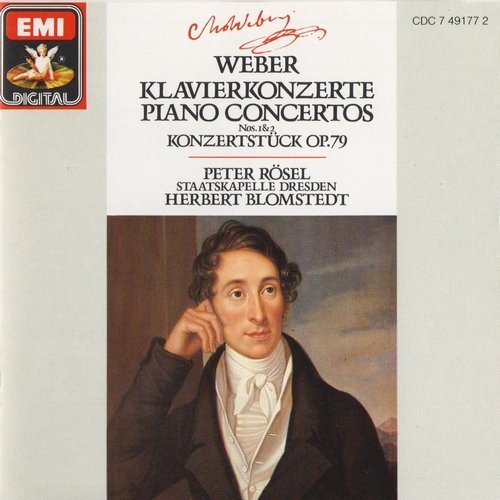
Peter Rösel, Staatskapelle Dresden, Herbert Blomstedt - Carl Maria von Weber - Piano Concertos (1987)
BAND/ARTIST: Peter Rösel, Staatskapelle Dresden, Herbert Blomstedt
- Title: Carl Maria von Weber - Piano Concertos
- Year Of Release: 1987
- Label: EMI Digital
- Genre: Classical
- Quality: FLAC (image+.cue,log,scans)
- Total Time: 60:57
- Total Size: 248 Mb
- WebSite: Album Preview
Tracklist:
1. Konzertstuck in F Minor, Op. 79
Piano Concerto No. 1 in C Major, Op. 11
2. I. Allegro
3. II. Adagio
4. III. Finale, presto
Piano Concerto No. 2 in E flat Major, Op. 32
5. I. Allegro maestoso
6. II. Adagio
7. III. Rondo, presto
Performers:
Peter Rösel, piano
Staatskapelle Dresden
Conductor: Herbert Blomstedt
1. Konzertstuck in F Minor, Op. 79
Piano Concerto No. 1 in C Major, Op. 11
2. I. Allegro
3. II. Adagio
4. III. Finale, presto
Piano Concerto No. 2 in E flat Major, Op. 32
5. I. Allegro maestoso
6. II. Adagio
7. III. Rondo, presto
Performers:
Peter Rösel, piano
Staatskapelle Dresden
Conductor: Herbert Blomstedt
A new recording of Weber's piano concertos was obviously long overdue, and this one fits the bill more than adequately, coming as it does generously coupled with the much better known Konzertstück and in first-rate sound quality from HMV. Not the least of its virtues is the light it casts on the origins of the piano idiom of Chopin and Liszt and, in the case of the Konzertstück, on the very foundations of the romantic concerto. I wouldn't envy any historian out to determine who was responsible for which innovation in the first two decades of the nineteenth century, but certainly to hear so many fully-formed romantic textures in music dating from 1810-21 is an instructive, not to say startling, experience.
But it would be wise not to raise expectations too high. Unless you positively salivate at the thought of vast chains of double thirds, diminished seventh arpeggios, chromatic melismas, and other tools of the cadenza-busker's trade, you will probably find the concertos as thin in substance as they are rich in keyboard fantasy. In both cases the adagio slow movements strike me as the most interesting. Each one introduces the soloist effectively at a harmonic tangent and lets him spin traceries of sound against the most discreet of string accompaniments (each also concludes with strange tremolo chords which sound as incongruous as they look—could this really be what Weber intended?).
The other movements are entertaining in a way and certainly innocent of over-intellectualism. Peter Rösel competently supplies the necessary cadenza for the first movement of the E flat major Concerto, not too difficult an exercise when so much of the main movement resembles an accompanied cadenza anyway. One cannot but admire the conscientiousness of his performances, for this is truly a case of piano writing which is as difficult as it sounds, if not more so—Weber had freaky hands and was not afraid to exploit their special abilities. Rösel's playing is, however, a little short on eloquence, so that even the much more adventurous Konzertstück is made to sound rather conventional. The accompaniments, too, are less precise than one might expect from this source, especially in woodwind intonation. Still, the Konzertstück comes to life with its extraordinary octave glissandos, and the finesse of passagework offsets his lack of tonal variety. Overall this is as satisfying a record of these works as we are likely to have For a long time, and anyone interested in the repertoire need not hesitate. -- Gramophone
But it would be wise not to raise expectations too high. Unless you positively salivate at the thought of vast chains of double thirds, diminished seventh arpeggios, chromatic melismas, and other tools of the cadenza-busker's trade, you will probably find the concertos as thin in substance as they are rich in keyboard fantasy. In both cases the adagio slow movements strike me as the most interesting. Each one introduces the soloist effectively at a harmonic tangent and lets him spin traceries of sound against the most discreet of string accompaniments (each also concludes with strange tremolo chords which sound as incongruous as they look—could this really be what Weber intended?).
The other movements are entertaining in a way and certainly innocent of over-intellectualism. Peter Rösel competently supplies the necessary cadenza for the first movement of the E flat major Concerto, not too difficult an exercise when so much of the main movement resembles an accompanied cadenza anyway. One cannot but admire the conscientiousness of his performances, for this is truly a case of piano writing which is as difficult as it sounds, if not more so—Weber had freaky hands and was not afraid to exploit their special abilities. Rösel's playing is, however, a little short on eloquence, so that even the much more adventurous Konzertstück is made to sound rather conventional. The accompaniments, too, are less precise than one might expect from this source, especially in woodwind intonation. Still, the Konzertstück comes to life with its extraordinary octave glissandos, and the finesse of passagework offsets his lack of tonal variety. Overall this is as satisfying a record of these works as we are likely to have For a long time, and anyone interested in the repertoire need not hesitate. -- Gramophone
Classical | FLAC / APE | CD-Rip
As a ISRA.CLOUD's PREMIUM member you will have the following benefits:
- Unlimited high speed downloads
- Download directly without waiting time
- Unlimited parallel downloads
- Support for download accelerators
- No advertising
- Resume broken downloads


